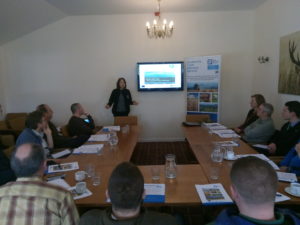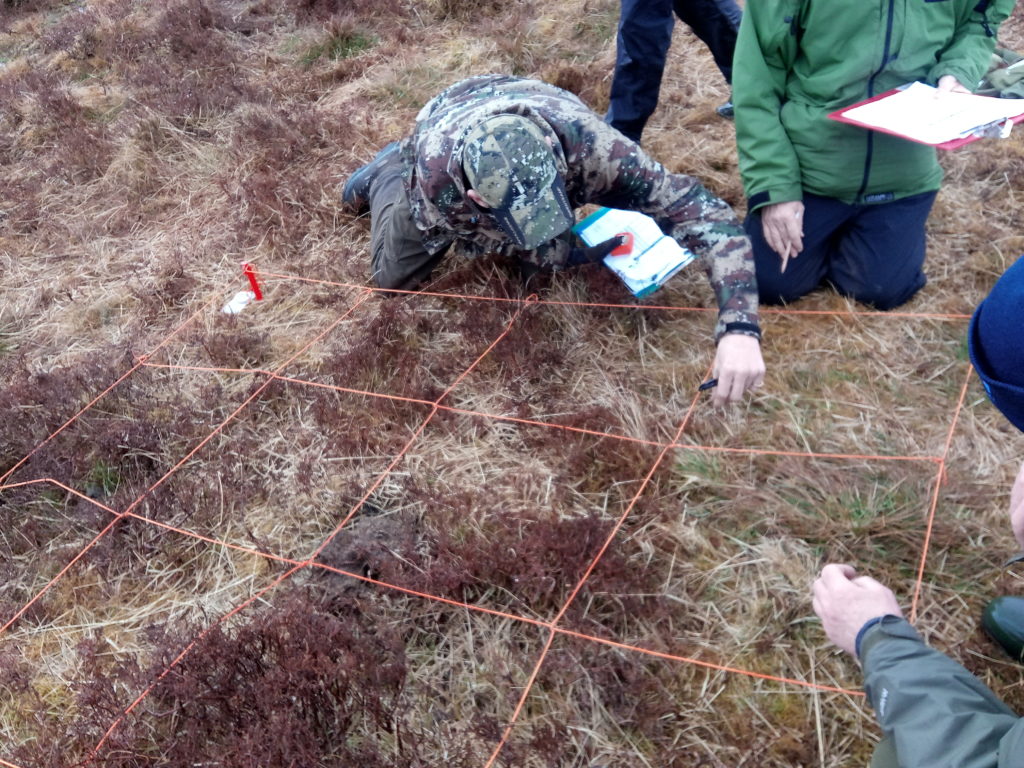Upland Habitats & Impact of Herbivores: Drymen – Event Summary
27 March 2018The impacts of grazing of both domestic and wild herbivores affect the long term sustainability of upland habitats.
For upland managers it is important to recognise these different upland habitats and be able to identify their condition in relation to management. Habitat condition, as indicated by the vegetation type, cover and height is determined by the level of grazing and trampling. Good habitat condition is important for supporting wildlife and for optimum carbon storage capacity both important factors in sustainable land management.
The meeting was held in the Winnock Hotel Drymen. The first part of the meeting included an indoor presentation with an introduction to upland habitat types and their main characteristics including peat depth and vegetation and the impact of different types of herbivore and how to examine these impacts using standard and recognised means. There was an explanation of the value of the peatland habitats for wildlife, carbon and water followed by discussion.
including peat depth and vegetation and the impact of different types of herbivore and how to examine these impacts using standard and recognised means. There was an explanation of the value of the peatland habitats for wildlife, carbon and water followed by discussion.
A simple habitat assessment can be carried out at plots across each habitat type to give a base-line of habitat condition. Regular assessments can be used to show local grazing or trampling pressures and trends over a period of time on an upland estate or at a wider deer management group level. The information can be mapped using GIS to produce visual reports on grazing and trampling impacts to help set targets for stock or deer management and enable managers to see where they are doing well and where any improvements can be made.
In the afternoon the attendees were taken to nearby hill ground where the morning’s theory was put into practice. Several quadrats were laid out on different habitats and the attendees had a chance to go through the methodology on site and learn in a practical way. There was lots of opportunity for discussion and lots of questions asked regards the practicality in the field.
Those present had a range of backgrounds and interests; from deer stalkers and managers to NatureScot surveyors and National park managers. They each oversee estate deer management, and this will help them monitor and understand impacts across thousands of hectares of moorland habitat
Please use the links below to download the presenations and the handouts available to take away on the day.
- Habitat Monitoring presentation slides used by Gillian McKnight at Upland Habitat & Impact of Herbivores events
- Habitat Monitoring presentation slides used by Gillian McKnight at Upland Habitat & Impact of Herbivores events
- Topics: Climate Change
- Impacts of deer on upland habitats – presentation slides by Gillian McKnight
- These are the presentation slides used by Gillian McKnight at the Upland Habitats and Impact of Herbivores events.
- Topics: Climate Change
- FAS: Guidance for Habitat Impact Assessment Surveys
- This guidance document explores Habitat Impact Assessment Surveys. Assessing the habitat impacts of grazing on habitats requires looking at the various effects of herbivores, notably red deer, on the main habitats that occur in the uplands. These habitat types are dwarf shrub heath (wet & dry) and blanket bog, which are the most extensive habitats in the uplands.
- Impact indicators in upland habitats – information sheet
- This is a copy of an information sheet available at the Upland Habitat and Impact of Herbivores event.
- Topics: Climate Change
- Blanket Bog Data Sheet – Habitat Impact Assessment
- A copy of a data sheet that can be used in an Upland habitat impact assessment.
- Topics: Climate Change
- Dwarf shrub heath data sheet – Habitat Impact Assessment
- A copy of a data sheet that can be used to monitor dwarf shrub in an upland habitat impact assessment
- Topics: Climate Change
- Technical Note (TN686): Conservation Grazing for Semi-Natural Habitats
- Grazing is an important process in maintaining semi-natural grasslands, wetlands and heathlands of conservation interest. This technical note provides guidance on developing grazing plans for a range of habitats in Scotland.
Sign up to the FAS newsletter
Receive updates on news, events and publications from Scotland’s Farm Advisory Service

